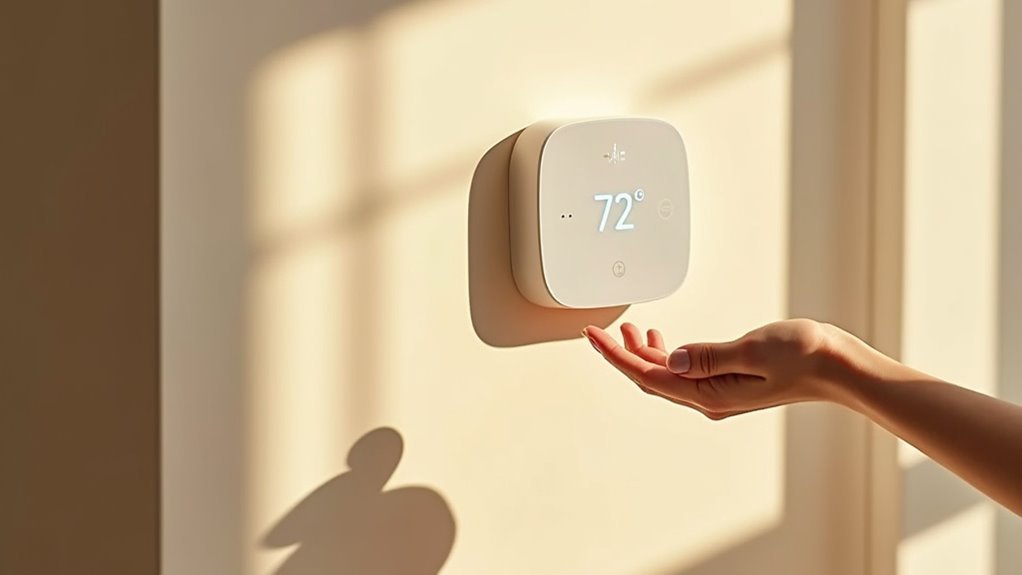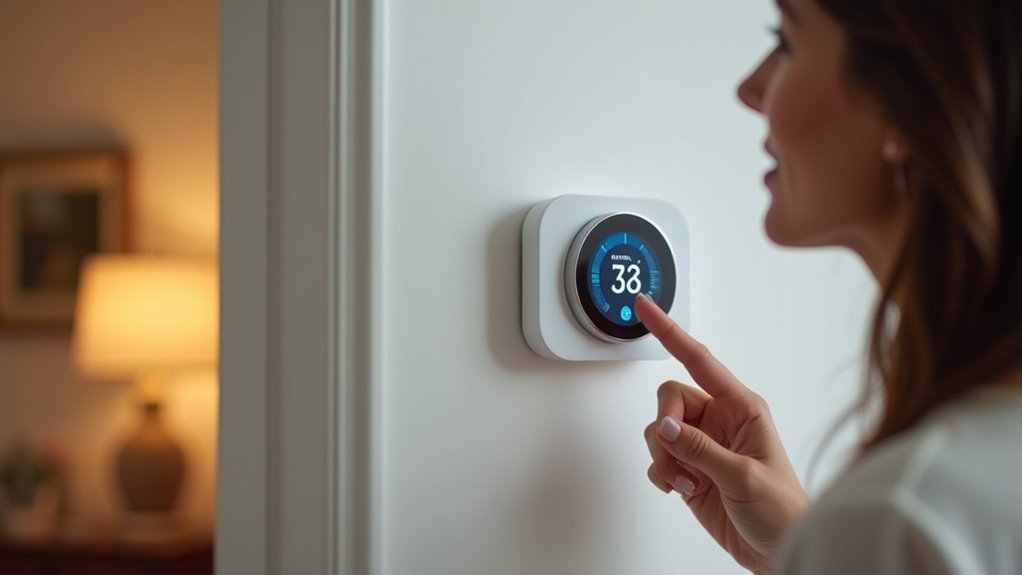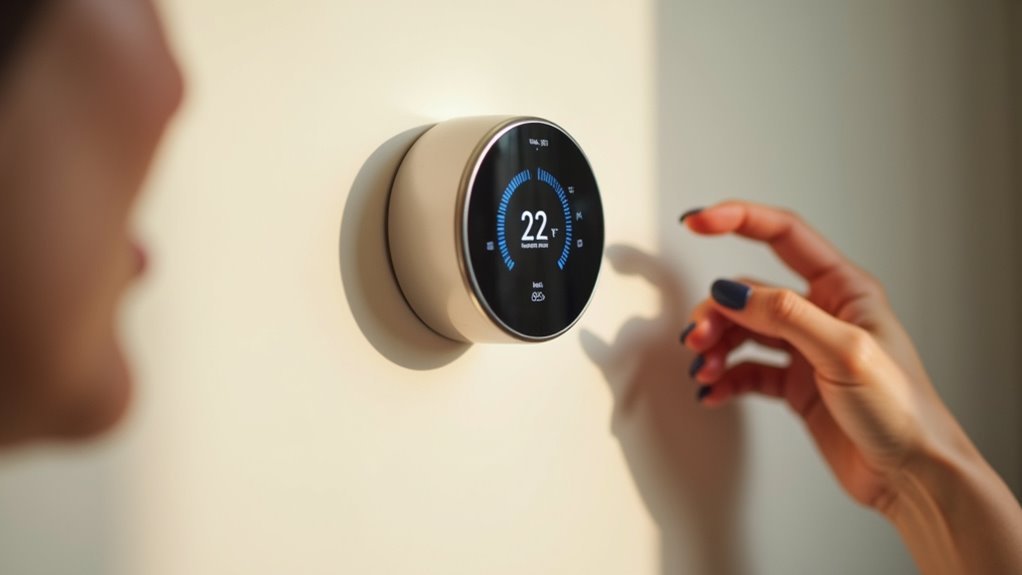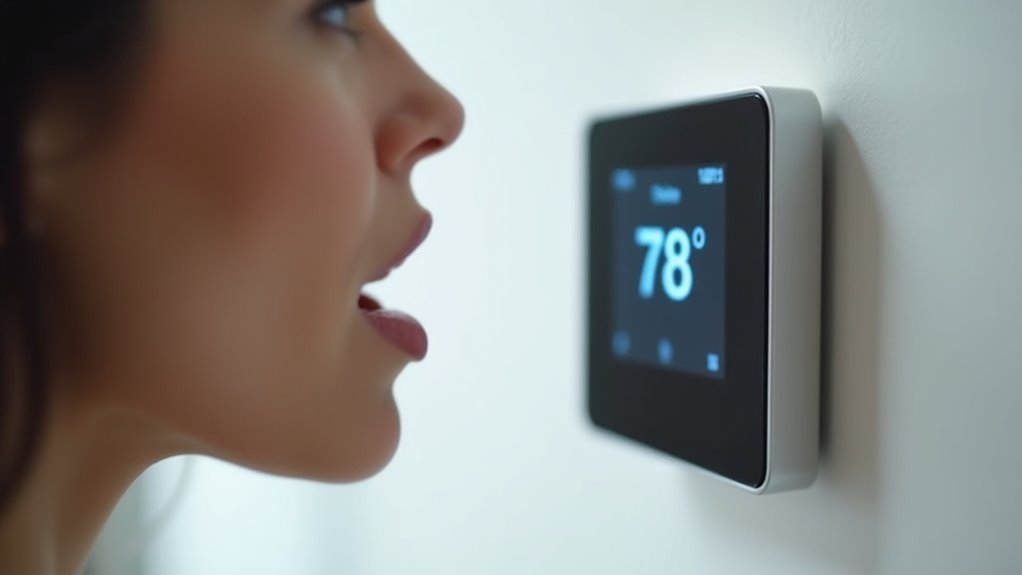You’re probably using your smartphone dozens of times daily to control various aspects of your life, but you might not realize how effortlessly you can manage your home’s temperature with simple voice commands. Whether you’re cooking dinner with messy hands or settling into bed for the night, speaking to your smart thermostat eliminates the need to physically adjust settings. The range of available commands extends far beyond basic temperature changes, offering sophisticated control options that most homeowners haven’t discovered yet.
Understanding Voice-Controlled Smart Thermostats

The revolution in home climate control has arrived with voice-controlled smart thermostats that respond to your spoken commands through virtual assistants like Amazon Alexa, Google Assistant, and Apple Siri.
These innovative devices eliminate the need to physically adjust temperature settings, allowing you to make changes from anywhere in your home using simple voice control.
Smart thermostats equipped with voice recognition technology utilize natural language processing to interpret your commands accurately, accommodating various accents and dialects.
You can easily issue commands like “Set the temperature to 70 degrees” or “Set my thermostat to cooling” for immediate adjustments.
This hands-free approach enhances energy efficiency by enabling quick temperature modifications, reducing energy waste while providing unprecedented convenience in managing your home’s climate comfort.
Setting Up Your Smart Thermostat for Voice Control
You’ll need to choose a smart thermostat that works with your preferred voice assistant before you can start controlling your home’s temperature with voice commands.
The most popular options include Amazon Alexa, Google Assistant, and Apple Siri, so check your thermostat’s compatibility specs first.
Once you’ve confirmed compatibility, you can move forward with connecting your devices and setting up the voice assistant integration.
Compatible Device Selection
Before diving into voice commands, selecting a smart thermostat that’s compatible with your preferred voice assistant is essential for seamless integration.
You’ll want to make sure your chosen device works with Amazon Alexa, Google Assistant, or Apple Siri depending on your existing smart home devices setup.
Check the thermostat’s specifications before purchasing to confirm voice assistant compatibility. Popular brands like Nest, Ecobee, and Honeywell typically support multiple voice assistant platforms, giving you flexibility in your smart home ecosystem.
Consider your current voice assistant preference and existing smart home devices when making your selection. If you’re already using Alexa-enabled devices throughout your home, choose a thermostat that integrates smoothly with Amazon’s ecosystem for consistent voice control across all your connected devices.
Voice Assistant Integration
Once you’ve selected a compatible smart thermostat, setting up voice control requires connecting your device to Wi-Fi and downloading your voice assistant’s dedicated app.
For successful voice assistant integration, you’ll need the Amazon Alexa app for Alexa or Google Home app for Google Assistant. Enable your smart thermostat’s specific skill within the voice assistant app and link your accounts to establish seamless communication between devices.
After linking accounts, test the setup with basic commands like “Set the temperature to 72 degrees.” Use clear, specific voice commands to guarantee accurate execution.
Verify that your voice assistant correctly understands and executes temperature adjustments. Remember to regularly update both your smart thermostat and voice assistant software to maintain compatibility and enhance functionality throughout your home automation experience.
Essential Temperature Control Commands

When you’re ready to take control of your home’s climate, mastering essential voice commands transforms how you interact with your smart thermostat.
You’ll quickly discover that direct temperature adjustments are straightforward—simply say “Set the temperature to 70 degrees” to reach your desired comfort level immediately.
For precise modifications, commands like “Raise the thermostat by 2 degrees” or “Lower the temperature by 3 degrees” give you granular control.
Your smart devices also respond to operational changes, such as “Set my thermostat to cooling” or “Switch to heating mode” for seasonal shifts.
You can monitor current conditions by asking “What is my home’s temperature?”
Additionally, energy-conscious commands like “Turn on Eco mode” help reduce consumption while maintaining comfort.
Adjusting Temperature With Precision Voice Commands
You can achieve exact home comfort by using specific temperature setting commands that target your desired degree.
Voice controls let you make incremental adjustments up or down by stating precise amounts, giving you complete control over your environment.
These precision commands guarantee you’ll reach your ideal temperature without the guesswork of traditional manual adjustments.
Specific Temperature Setting Commands
Three primary types of voice commands enable precise temperature control in your smart home system.
These commands let you communicate directly with your thermostat without physical interaction, making climate adjustments effortless and immediate.
You can use specific voice commands to control your thermostat temperature through these methods:
- Direct setting: “Set my thermostat to 70 degrees” for exact temperature control
- Incremental adjustments: “Increase my thermostat temperature by 2 degrees” or “Lower by 3 degrees”
- Mode changes: “Set my thermostat to cooling” or “Set to heating mode”
- Quick corrections: “Make it warmer” or “Cool down the house”
- Energy optimization: Real-time adjustments based on immediate comfort needs
These voice commands enhance convenience while helping you optimize energy efficiency through precise, responsive climate control.
Incremental Adjustment Voice Controls
While broad temperature commands get the job done, incremental adjustment voice controls offer the precision you need for perfect comfort.
These commands let you make fine adjustments like “Increase my thermostat temperature by 2 degrees” or “Lower my thermostat temperature by 3 degrees.” You’ll find this level of control particularly useful when you’re busy multitasking and can’t physically interact with your device.
Using specific phrases guarantees your voice assistant interprets commands accurately, preventing temperature mishaps.
When you set your thermostat with incremental adjustments, you’re responding precisely to changing comfort needs without overdoing it. This precision helps maintain energy efficiency by avoiding drastic changes that waste power.
You’ll achieve tailored comfort while keeping energy costs in check through careful, measured adjustments.
Mode Switching Commands for Heating and Cooling

As seasons change and weather patterns shift throughout the year, you’ll need efficient ways to switch your smart thermostat between heating and cooling modes using simple voice commands.
Mode switching becomes effortless when you master these essential commands for your heating and cooling systems.
Your voice assistant responds to clear, direct commands that instantly change your thermostat’s operation:
- “Set my thermostat to heating” – Activates heating mode for cold weather
- “Set my thermostat to cooling” – Switches to cooling mode during warm periods
- “Set my thermostat to auto” – Enables automatic temperature adjustments based on preferences
- “What mode is my thermostat in?” – Checks current heating or cooling status
Works seamlessly with Alexa, Google Assistant, and Siri for all-encompassing home control.
These commands enhance energy efficiency while providing immediate comfort adjustments.
Scheduling Temperature Changes Through Voice
You can transform your daily routine by using voice commands to set automatic temperature schedules that align with your lifestyle.
Creating recurring voice routines allows you to establish consistent heating and cooling patterns without manually adjusting your thermostat each day.
Voice scheduling also helps you adapt to seasonal changes by easily modifying your heating patterns as weather conditions shift throughout the year.
Setting Daily Temperature Schedules
When you integrate voice commands with smart thermostats, you’ll discover that setting daily temperature schedules becomes remarkably straightforward and efficient. You can customize your home’s comfort level throughout the week by simply speaking your preferences.
Here are key ways to maximize your voice-controlled scheduling:
- Say “Set my thermostat to 68 degrees at 7 AM for heating” to guarantee morning warmth
- Create custom routines like “Activate Away Mode” for automatic energy-saving adjustments
- Schedule weekday-specific changes with “Set temperature to 70 degrees at 6 PM on weekdays”
- Use precise phrasing to improve command recognition accuracy
- Keep your thermostat’s software updated for peak voice control performance
These voice commands transform your daily temperature management into an effortless, personalized experience.
Creating Recurring Voice Routines
Smart home automation reaches its full potential when you establish recurring voice routines that handle your temperature preferences automatically. You can program your voice assistant to adjust your thermostat at specific times using voice commands like “Set my thermostat to 72 degrees at 7 AM every weekday.” These routines integrate seamlessly with other smart home devices for thorough environmental control.
| Routine Type | Example Voice Command |
|---|---|
| Daily Schedule | “Set heating to 68 degrees every evening at 6 PM” |
| Workday Automation | “Lower temperature to 65 degrees weekdays at 8 AM” |
| Weekend Comfort | “Increase temperature to 74 degrees Saturday mornings” |
You’ll find these customizable routines adapt easily to seasonal changes or lifestyle adjustments through simple voice modifications.
Adjusting Seasonal Heating Patterns
Building upon these foundational routines, seasonal heating patterns take your voice-controlled temperature management to the next level by adapting to changing weather conditions throughout the year.
Smart thermostats excel at implementing these automated seasonal adjustments through simple voice commands.
You can enhance your home’s comfort and efficiency with these seasonal voice strategies:
- Say “Activate Winter Mode” to implement pre-set cold weather temperature schedules
- Command “Set weekday morning temperature to 70 degrees” for consistent winter comfort
- Use “Schedule 68 degrees at 6 PM” for evening warmth during colder months
- Create energy-saving patterns with “Lower temperature when away” commands
- Establish off-peak heating schedules to reduce unnecessary energy consumption
These voice commands can lower your heating bills by 10-15% while maintaining peak comfort throughout winter.
Energy-Saving Commands for Eco-Friendly Control
Although traditional thermostats require manual adjustments throughout the day, voice-activated energy-saving commands let you enhance your home’s temperature control with simple spoken instructions.
Smart home voice commands like “Set my thermostat to Eco mode” automatically adjust settings during peak hours or when you’re away, reducing unnecessary energy usage.
You can schedule cooling by saying “Schedule cooling for 8 AM” to avoid wasting energy on an empty house.
Commands such as “Lower my thermostat temperature by 5 degrees” greatly decrease consumption during warmer months, cutting cooling costs.
Activating “energy-saving mode” limits temperature fluctuations for maximum efficiency.
Don’t forget maintenance reminders like “Schedule filter change alert” to keep your HVAC system running efficiently and consuming less energy.
Room-Specific Temperature Management Commands
Beyond house-wide energy efficiency, you can fine-tune comfort levels in individual rooms using targeted voice commands.
Smart thermostats with room sensors enable precise temperature control through simple spoken instructions.
These voice commands give you complete room-by-room control:
- “Set the living room temperature to 68 degrees” – Direct temperature control for specific spaces
- “Set the upstairs to cool mode” – Custom scenes for multiple rooms or floors
- “Increase the temperature in the guest room by 3 degrees” – Multi-zone adjustments for personalized comfort
- “Turn on heating in the kitchen” – Room-specific heating or cooling activation
- “Set the temperature in the office to eco mode” – Energy-efficient settings for individual spaces
You’ll monitor and adjust temperatures precisely based on occupancy and personal preferences throughout your home.
Voice Commands for Temperature Monitoring
You’ll want to stay informed about your home’s temperature conditions through strategic voice commands that provide real-time data.
These monitoring commands let you check current temperatures, verify thermostat settings, and track energy consumption patterns without leaving your current location.
Mastering these temperature monitoring techniques guarantees you’re always aware of your home’s climate status and system performance.
Current Temperature Checking
How can you instantly know your home’s temperature without walking to the thermostat? Voice commands make current temperature checking effortless and immediate.
Simply speak your request, and you’ll receive precise feedback about your indoor climate conditions.
Here are five key benefits of using voice commands for temperature monitoring:
- Instant updates – Get real-time temperature readings without moving from your current location
- Enhanced convenience – Perfect for busy moments when you can’t physically check the thermostat
- Energy efficiency – Regular monitoring helps improve heating and cooling settings
- Accessibility support – Ideal solution for individuals with mobility challenges
- Comfort management – Stay informed about indoor conditions to maintain ideal living environments
Use “What is my home’s temperature?” for current readings and “What is my thermostat’s temperature?” for set point verification.
Set Point Monitoring
While checking your current temperature tells you what’s happening now, monitoring your thermostat’s set point reveals what temperature your system’s actually targeting.
Voice commands like “What is my thermostat’s temperature?” instantly provide your current set point, helping you understand whether your HVAC system’s heating or cooling to reach that goal.
This monitoring capability enhances your awareness of home heating and cooling efficiency, promoting energy conservation. You’ll quickly spot discrepancies between actual room temperature and your target setting.
Regular voice-based set point checking helps you establish consistent climate control habits and improve energy usage.
Your home automation system makes it effortless to set the temperature and monitor performance through simple voice queries, enabling you to maintain ideal comfort levels without physically accessing the thermostat.
Energy Usage Tracking
Smart thermostats equipped with voice control transform energy monitoring from guesswork into precise data tracking. Your smart thermostat continuously analyzes consumption patterns, delivering actionable insights through simple voice commands.
This real-time energy usage information empowers you to make informed decisions about your home’s efficiency.
Voice commands activate thorough energy tracking features:
- Say “What’s my energy usage today?” to receive daily consumption reports
- Ask “When does my home use the most energy?” to identify peak usage periods
- Request “Show my monthly energy trends” for long-term pattern analysis
- Command “How much energy did heating use yesterday?” for specific system data
- Inquire “What’s my current energy consumption?” for immediate usage feedback
These voice-activated insights help you optimize schedules, reduce waste, and lower utility bills while maintaining comfort.
Troubleshooting Voice Command Recognition Issues
When your voice assistant fails to respond to temperature commands, several common culprits could be disrupting the recognition process. Background noise interferes with accurate command capture, so you’ll want to minimize distractions around your device. Your accent or dialect might cause misinterpretation, making clear, standard phrases essential for successful execution.
| Issue | Solution |
|---|---|
| Background noise interference | Minimize distractions near device |
| Accent/dialect misinterpretation | Use clear, standard phrases |
| Outdated software bugs | Update voice assistant regularly |
| Poor connectivity | Check Wi-Fi network strength |
| Privacy settings limiting learning | Adjust settings for better recognition |
Regular software updates fix bugs and improve recognition accuracy. You’ll need a robust Wi-Fi network since connectivity issues disrupt communication between your voice assistant and thermostat. Adjusting privacy settings allows your device to better understand your speech patterns over time.
Advanced Voice Features for Smart Climate Control
Beyond basic temperature adjustments, today’s smart thermostats offer sophisticated voice features that transform how you control your home’s climate.
These advanced capabilities make your voice commands more powerful and personalized.
Modern smart thermostats provide enhanced functionality through:
- Custom scheduling commands – Create specific voice commands like “Set my thermostat to 68 degrees at 7 PM” for automated daily routines
- Multi-language support – Issue commands in various languages, making devices accessible to non-English speakers
- Smart home integration – Use combined commands such as “Goodnight” to simultaneously adjust temperature and control other connected devices
- Geofencing automation – Automatically adjust temperature based on your location without voice activation
- Maintenance reminders – Set voice-activated alerts for HVAC upkeep tasks like filter replacements
Compatible Voice Assistants and Their Capabilities
These powerful features become accessible through the voice assistants that power your smart thermostat interactions.
Amazon Alexa, Google Assistant, and Apple Siri each offer unique capabilities for controlling your home’s temperature through voice commands.
Voice-controlled temperature management transforms how homeowners interact with their smart thermostats through intuitive spoken commands.
Alexa excels with energy-saving modes and straightforward temperature adjustments using phrases like “set the temperature to 72 degrees.”
Google Assistant stands out with its routine functionality, letting you combine thermostat controls with other smart home actions in single commands, plus detailed energy usage reporting.
Apple Siri provides seamless integration for iOS users with natural temperature modifications.
All three assistants handle basic queries about current settings and heating/cooling modes.
Your choice depends on your existing smart home ecosystem and preferred features for managing your smart thermostats effectively.
Security and Privacy Considerations for Voice Control
While voice control offers convenience for managing your smart thermostat, it introduces important security and privacy considerations that you’ll need to address.
Your voice-controlled devices constantly listen for wake words, creating potential risks for unintentional recordings and data privacy breaches. To protect yourself:
- Review and adjust privacy settings regularly to limit data sharing with third parties
- Implement voice pin codes for secure transactions to prevent unauthorized temperature changes or purchases
- Install software updates promptly, as they include essential security patches for voice recognition vulnerabilities
- Understand compatibility limitations between your thermostat and virtual assistants, which can impact system security
- Monitor what sensitive information your smart assistant collects during temperature control interactions
Taking these precautions guarantees you maintain both convenience and security while using voice commands for home temperature management.
Optimizing Your Voice Command Experience
How can you get the most out of your voice-controlled thermostat? Start by using clear, specific voice commands like “Set my thermostat to 70 degrees” to guarantee accurate temperature adjustments and minimize misinterpretation.
Create automated routines such as “Morning Mode” or “Away Mode” that adjust temperatures based on your daily schedule, enhancing both convenience and energy efficiency in your smart home setup.
Keep your thermostat’s software and voice assistant app updated regularly to prevent glitches and maintain peak functionality.
Educate all household members on proper voice command usage to maximize benefits and prevent confusion.
Most importantly, invest in a robust Wi-Fi network to maintain consistent connectivity between your smart thermostat and voice assistant, guaranteeing seamless operation of all voice commands.
Frequently Asked Questions
Can Alexa Control Your Thermostat?
Yes, you can use Alexa to control your compatible smart thermostat through voice commands. You’ll need to connect your thermostat to Wi-Fi and link it through the Alexa app first.
How to Control Temperature With Alexa?
You’ll control temperature with Alexa by saying “Alexa, set thermostat to [temperature]” or “Alexa, raise temperature by [number] degrees.” First, confirm your smart thermostat’s linked to the Alexa app properly.
How to Voice Control Your Nest Thermostat?
You’ll control your Nest Thermostat by setting it up with Google Assistant or Alexa first. Then use specific voice commands like “set thermostat to 72 degrees” or “switch to cooling mode.”
What Is Automatic Voice Control?
Automatic voice control lets you manage your home’s temperature hands-free using smart assistants like Alexa or Google Assistant. You’ll simply speak commands, and your thermostat adjusts automatically without manual input.





Leave a Reply